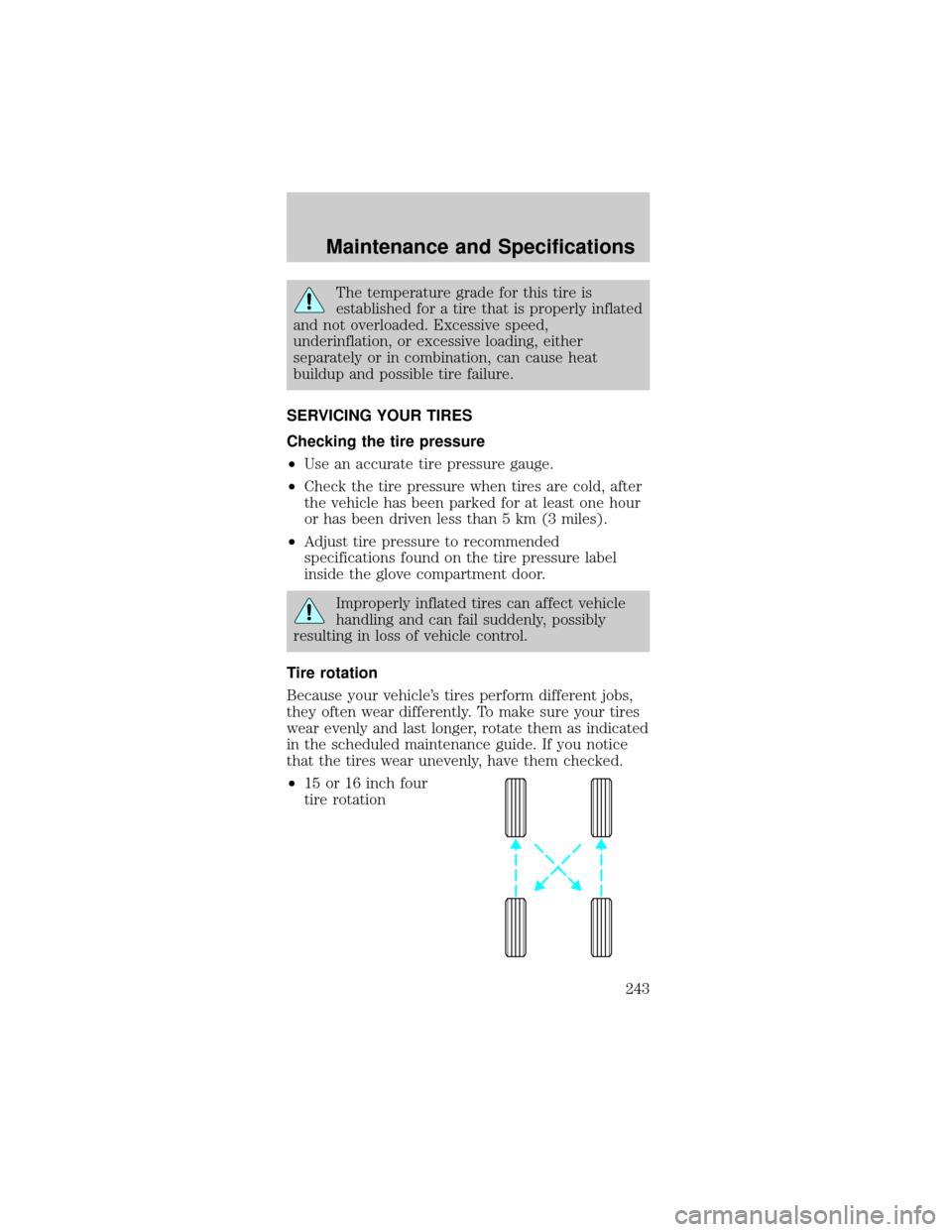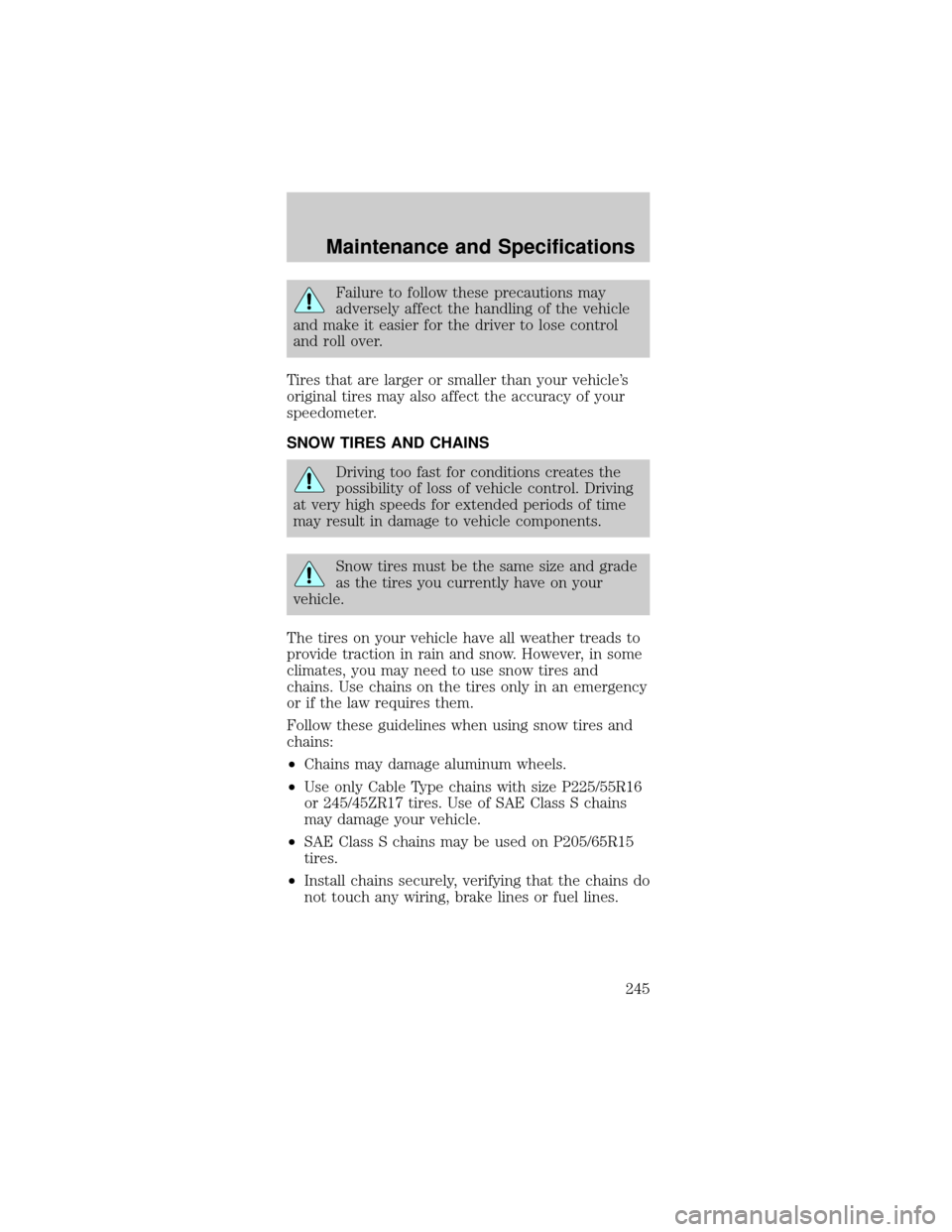Page 243 of 264

The temperature grade for this tire is
established for a tire that is properly inflated
and not overloaded. Excessive speed,
underinflation, or excessive loading, either
separately or in combination, can cause heat
buildup and possible tire failure.
SERVICING YOUR TIRES
Checking the tire pressure
²Use an accurate tire pressure gauge.
²Check the tire pressure when tires are cold, after
the vehicle has been parked for at least one hour
or has been driven less than 5 km (3 miles).
²Adjust tire pressure to recommended
specifications found on the tire pressure label
inside the glove compartment door.
Improperly inflated tires can affect vehicle
handling and can fail suddenly, possibly
resulting in loss of vehicle control.
Tire rotation
Because your vehicle's tires perform different jobs,
they often wear differently. To make sure your tires
wear evenly and last longer, rotate them as indicated
in the scheduled maintenance guide. If you notice
that the tires wear unevenly, have them checked.
²15 or 16 inch four
tire rotation
Maintenance and Specifications
243
Page 244 of 264
²17 inch four tire
rotation
Replacing the tires
Replace the tires when
the wear band is
visible through the tire
treads.
When replacing full size tires, never mix
radial bias-belted, or bias-type tires. Use
only the tire sizes that are listed on the tire
pressure decal. Make sure that all tires are the
same size, speed rating, and load-carrying capacity.
Use only the tire combinations recommended on
the label. If you do not follow these precautions,
your vehicle may not drive properly and safely.
Make sure that all replacement tires are of
the same size, type, load-carrying capacity
and tread design (e.g., ªAll Terrainº, etc.), as
originally offered by Ford.
Maintenance and Specifications
244
Page 245 of 264

Failure to follow these precautions may
adversely affect the handling of the vehicle
and make it easier for the driver to lose control
and roll over.
Tires that are larger or smaller than your vehicle's
original tires may also affect the accuracy of your
speedometer.
SNOW TIRES AND CHAINS
Driving too fast for conditions creates the
possibility of loss of vehicle control. Driving
at very high speeds for extended periods of time
may result in damage to vehicle components.
Snow tires must be the same size and grade
as the tires you currently have on your
vehicle.
The tires on your vehicle have all weather treads to
provide traction in rain and snow. However, in some
climates, you may need to use snow tires and
chains. Use chains on the tires only in an emergency
or if the law requires them.
Follow these guidelines when using snow tires and
chains:
²Chains may damage aluminum wheels.
²Use only Cable Type chains with size P225/55R16
or 245/45ZR17 tires. Use of SAE Class S chains
may damage your vehicle.
²SAE Class S chains may be used on P205/65R15
tires.
²Install chains securely, verifying that the chains do
not touch any wiring, brake lines or fuel lines.
Maintenance and Specifications
245
Page 246 of 264

²Drive cautiously. If you hear the chains rub or
bang against your vehicle, stop and re-tighten the
chains. If this does not work, remove the chains
to prevent damage to your vehicle.
²If possible, avoid fully loading your vehicle.
²Remove the tire chains when they are no longer
needed. Do not use tire chains on dry roads.
²The suspension insulation and bumpers will help
prevent vehicle damage. Do not remove these
components from your vehicle when using snow
tires and chains.
MOTORCRAFT PART NUMBERS
Component 3.8L OHV V6
engine4.6L SOHC V8
engine
Air filter element FA-1611 FA-1634
Fuel filter FG-986 FG-986B
Battery BXT-59 BXT-59
Oil filter FL-400S FL-820S
PCV valve EV-152 EV-98
Spark plugs* AWSF-42EE** AWSF-32P
* Refer to Vehicle Emissions Control Information
(VECI) decal for spark plug gap information.
**If a spark plug is removed for inspection, it must
be reinstalled in the same cylinder. If a spark plug
needs to be replaced, use only spark plugs with the
same service part number suffix letter as shown on
the engine decal.
Maintenance and Specifications
246
Page 264 of 264

Starting your
vehicle ...... 136±137, 139
jump starting ........ 174
Steering wheel
controls .............. 82, 85
tilting ....................... 82
T
Tachometer ............... 19
Tires ......... 170, 241±243
changing ........ 170±171
checking the
pressure ................. 243
replacing ................ 244
rotating .................. 243
snow tires and
chains .................... 245
tire grades ............. 242
treadwear .............. 242
Towing ..................... 161
recreational
towing .................... 161
trailer towing ........ 161
wrecker .................. 179
Traction control ...... 145
active light .............. 14
Traction-lok rear
axle .......................... 147
Transmission
automatic
operation ............... 148
fluid, checking
and adding
(automatic) ........... 238
fluid, checking and
adding (manual) ... 240
fluid, refill
capacities ............... 247lubricant
specifications. 249, 251
manual operation .. 154
Trip odometer ........... 19
Trunk ......................... 94
remote release .. 90, 98
Turn signal .......... 10, 74
V
Vehicle dimensions . 251
Vehicle Identification
Number (VIN) ......... 253
Vehicle loading ........ 158
Ventilating your
vehicle ...................... 141
W
Warning chimes ......... 15
Warning lights
(see Lights) ............... 10
Washer fluid ............ 206
Water, Driving
through .................... 158
Windows
power ....................... 83
Windshield washer
fluid and wipers
checking and
adding fluid ........... 206
checking and
leaning ..................... 81
operation ................. 81
replacing wiper
blades ...................... 82
Wrecker towing ....... 179
Index
264